Guide to Push notifications for E-commerce
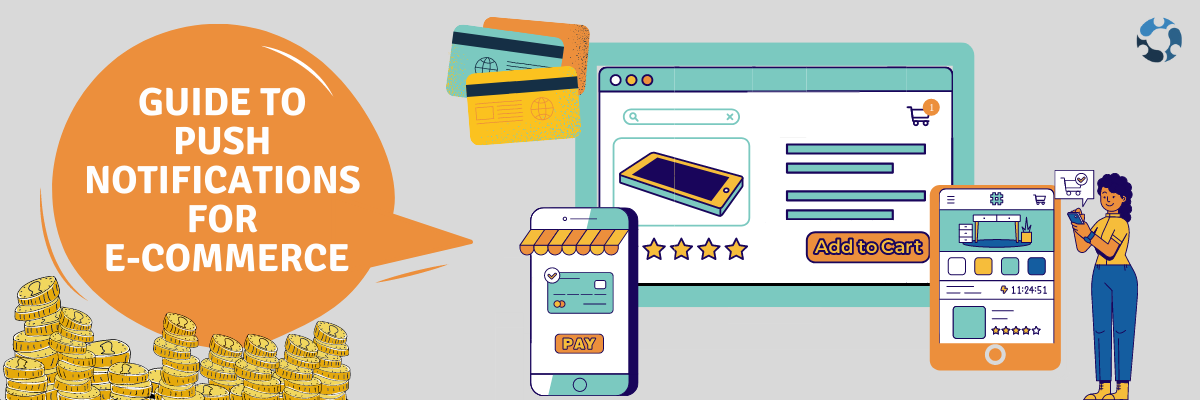
INTRODUCTION
Push notifications are clickable pop-up alerts that appear on a user’s device (desktop, tablet or mobile). Usually, they slide in the form of a banner on the screen, and they represent a real-time update.
Today, almost every marketeer integrates Push notifications into their marketing strategy in hopes of unleashing their full potential. Sending timely, relevant and well-crafted Push notifications to segmented audiences helps your businesses achieve goals across multiple channels.
On the other hand, we had the opportunity to see the power of the e-commerce industry over the past year. While some sectors stagnated during the pandemics and even experienced a decline (such as tourism and the aviation industry), others flourished. E-commerce platforms indeed occupy a high place on that list, and statistics are there to support these claims (source: Emarketer):
1. in 2020, over 2 billion people bought items online (which is 100 million more than in 2019),
2. e-commerce platforms earned almost $4.3 trillion (an increase of 28% compared to 2019),

3. the e-commerce industry participated with 18% in world retail sales (and research shows that this parameter will reach 21.4% by 2024).

According to the Digital IntheRound there are currently between 12 and 24 million e-commerce stores globally, and that only speaks of the competition store owners have among each other.
COMMUNICATION CHANNELS USED IN E-COMMERCE
Traditionally, marketing professionals most often use the following channels in communication with clients:
1. EMAIL
Do you know a person who does not have an email address? That’s right, in today’s world, it is almost impossible to function and live without an email address, so it is not surprising that most marketers go for this type of communication.
Through emails, they usually provide subscribers with information about discounts, order status, promotion of products that are often bought together, etc.
However, on the other hand, email communication has its drawbacks. The opt-in process for a newsletter is relatively long, and only those interested in your brand will subscribe. Furthermore, there is always a chance that promotional emails will end up in the spam/junk folder. In addition, Super Office research shows that email open rates are only around 21% in the first hour, meaning people can easily see a sale email too late.
2. SOCIAL NETWORKS
Today, there is almost no brand that does not have its profiles on social networks. However, unless you are one of the few top world brands, it will be tough to build reach, engagement and follower base.
Although you can give live, real-time information about restock, discounts or announce a new collection on social networks, it won’t mean much to you if no one (or there are tiny people) to see that information. In general, social networks are a place through which you need to build your brand and make it recognizable in the sea of the same or similar products.
3. SMS
It is one of the fastest ways to communicate with subscribers, which unfortunately cannot be used in every situation. It is most often used to send short (due to character limits) messages that notify the type: Your package is on its way. Additionally, the disadvantage is that SMS messages are exclusively textual.
This can be compensated in some way by creating Viber communities, which again require the consent and will of the individual to join them. They are a great way to deliver interactive content to thousands of users simultaneously, but be careful not to end up being too spammy.
PUSH NOTIFICATIONS AS A COMMUNICATION CHANNEL ON E-COMMERCE
Now that you have read more about all communication channels of the traditional type, the question arises: Where exactly and how do Push notifications fit?
The answer to that question is straightforward: Push notifications to take all the best from the above types of communication. With their unique features, they compensate for the shortcomings of those same channels.
Unlike subscribing to a newsletter, the opt-in process for Push notifications takes much less time, and the user is more likely to choose to receive notifications.
Emails often end up in a spam folder or mark them as read (without prior reading). Push notifications pop up in the corner of the screen and are almost impossible not to notice (even when the app or browser are not active).
Even if your e-commerce does not have a mobile app, you can send web push notifications to your users.
Sending information in real-time - because, let’s be honest, how fast do you check your phone after hearing the notification sound?
Advertising on other sites is a good idea, but users’ chances of an ad blocker that will automatically ban the display of such content are high. Fortunately, Push notifications are immune to ad blockers.
The advanced statistics and analytics that you get through Push notifications can give you essential information to plan your upcoming campaigns.
The option for retargeting audiences by segments means sending highly personalized messages to groups of individuals who have something in common.
Now that we have seen how and where exactly Push notifications fit into the marketing strategy, it is time to look at specific examples that you can start using today on your e-commerce.
To do so, subscribe to Ocamba and start your 14-day free trial and see for yourself the true power of Push notifications.
PROVEN EXAMPLES OF PUSH NOTIFICATIONS STRATEGY FOR YOUR E-COMMERCE
1. Abandoned cart alerts
Research done by Baymard Institute revealed that the cart abandonment rate is as high as 70%. This means that profit loss from cart abandonment is around $4 trillion annually.
One of the ways to lower your cart abandonment rates would be to design a whole strategy around it by retargeting the users who left something in their cart.
- Send a reminder that they left something in their cart. - Use FOMO - Tell them about a Discount - Retarget them
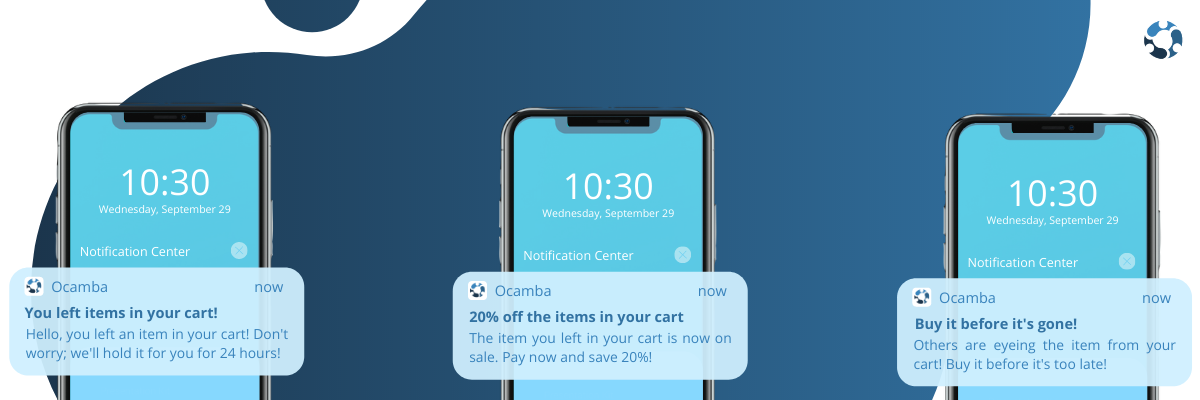
2. Suggesting items that are frequently bought together
Amazon claims that 35% of its sales are through cross-selling and up-selling (read more at Forbes Magazine). If you ever bought anything from the “customers also bought” or “frequently bought together”, you fall as a victim of cross-selling.
So, why don’t you implement it today to your e-commerce via Push notifications? Think of it as a notification to buy something that nicely compliments something your customer has already purchased.
For example, if your customer bought an engagement ring recently, chances are they will be buying wedding rings very soon. Forestall them by sending a Push notification about wedding rings and, why not, insert a coupon code for a discount available for a limited time only. This way, you will create a sense of urgency that will likely be seen as a “once in a lifetime” offer to your customer.
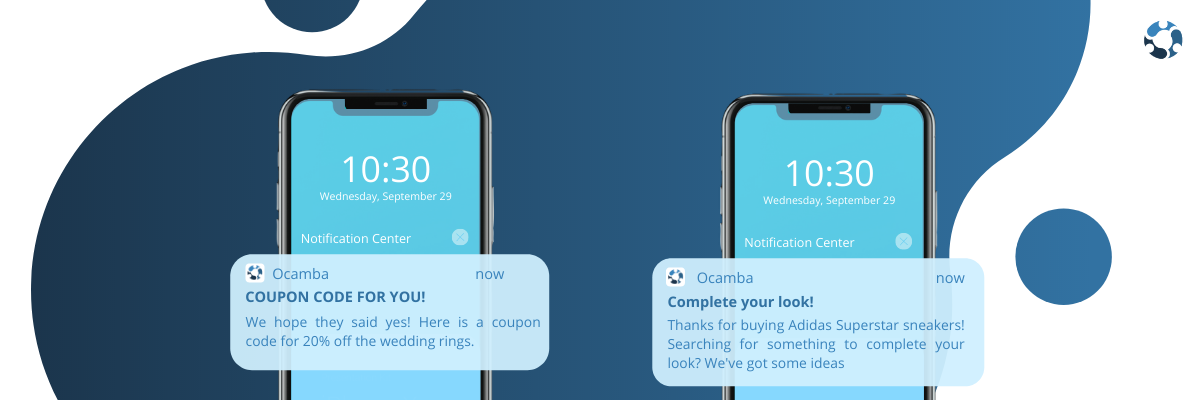
3. Announcements
Push notifications are a great way to communicate almost anything to your audience. Here are five commonly used methods of making announcements via Push.
- New collection
So you have a new collection arriving soon? Alert your subscribers about it and create a strategy around its promotion.
- Sales
Notify users about an upcoming or current sale. Keep in mind that retargeting can come in handy here. If you already know a user searched for sneakers, and they will be on sale, why not notify them about it?
- Free shipping
Let your subscribers know about the free shipping deal on your e-commerce by sending them a Push notification.
- Notice about an item being back in stock
Retarget the user who was previously interested in a product sold out by informing them it’s back in stock.
- Wishlist sale
When you put an item on a wishlist, it means two things either you like it or you plan on buying it shortly. So a little persuasion might help you close the sale. Notify a user when an item from their wishlist is on sale or nudge them into buying it by offering a coupon code for a discount on that particular item.
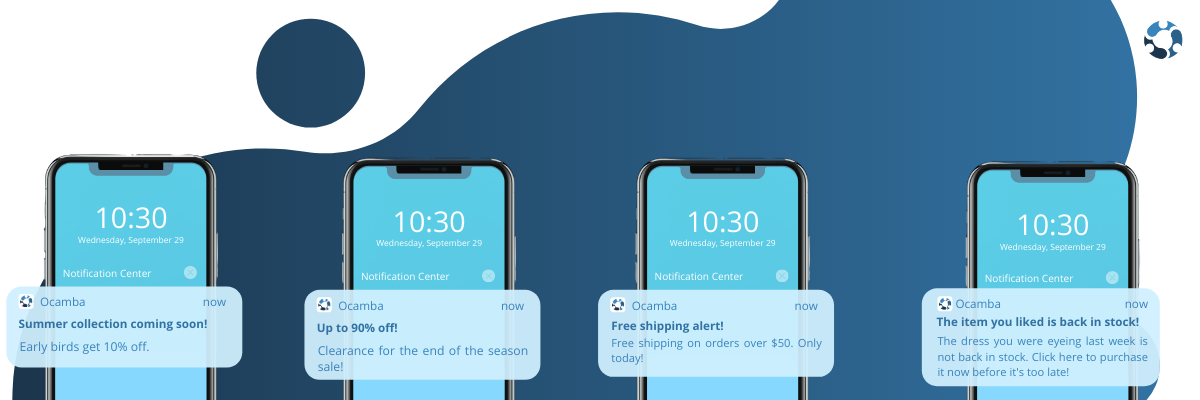
4. Promo codes for special occasions
In life, almost nothing is certain, except a few holidays you can use to boost your sales 😆. Offer promotions, discount codes and bundles to your subscribers on Valentine’s Day, Halloween, Christmas, etc.
But don’t stop there just yet. Leverage the full potential of the information your subscribers share with you on their profiles. Ask them to fill in their birthday and anniversary days and send them personalized offers for these occasions.
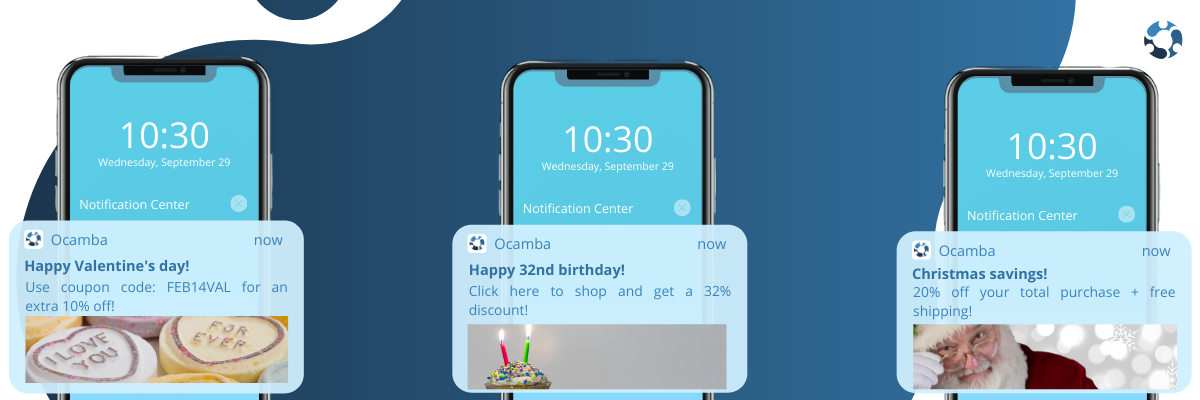
5. Track your order
Push notifications can allow your subscribers to track their orders through the whole delivery process. They can track their parcel every step of the way in real-time.
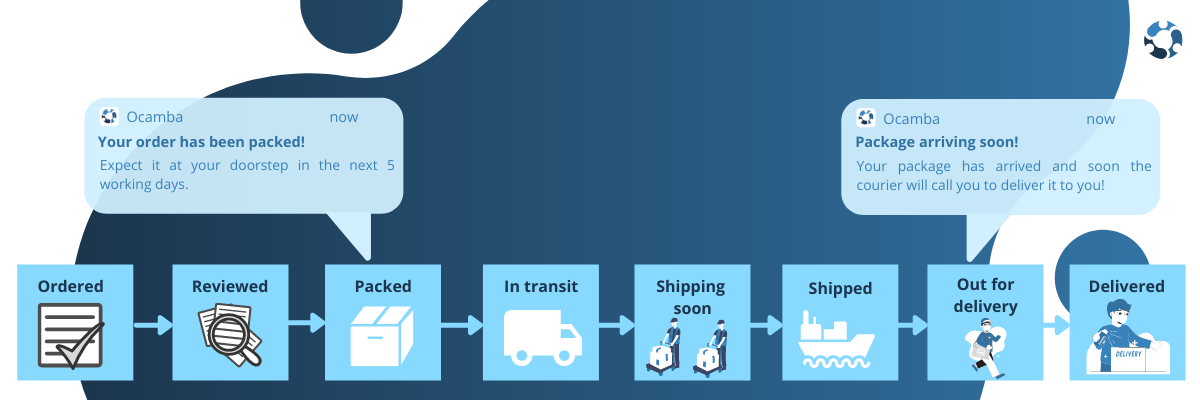
6. Reengage users
The most potent way Push notifications work is their ability to reengage users that match specific criteria. For instance, you can target users that frequently visit and scroll through your website but never buy anything. You can “wake up” users that have been inactive for a while and even promote special offers to those who set up an account or download your app.
7. Review and feedback
Ask your customers to provide you with feedback on their shopping experience or to write a review of the product they bought. Furthermore, you can set up a strategy by giving away a discount code when someone leaves a certain number of comments and reviews of your products.

PRO TIPS FOR SENDING PUSH NOTIFICATIONS
Once you decide which Push notification strategies you want to implement in your e-commerce, the real question arises: How do I make my Push notifications effective? Here, we give you pro tips on how to do it and thus avoid commonly made mistakes.
1. Don’t show your opt-in push prompt immediately when someone lands on your e-commerce.
Firstly, many popular browsers (Mozilla Firefox and Google Chrome) see this as a violation and won’t display your conformational prompt.
Secondly, as users who just got onto your website, you might not even know what it has to offer to you just yet.
So for prompt, choose to have a delay, and the best way to do so is to require user interaction before showing it (e.g. click on a page). For cheat codes on this, please read our previous blog post.
2. Use the prompt wisely.
Follow the analytics to see on which page the user was when they subscribed for Push notifications. This way, you will know which products they were interested in.
3. Don’t spam subscribers.
Although it might sound impressive to send Push notifications about everything on your store - fight that urge and don’t do it! Ideally, you would want to send 2 to 3 messages per week or even one per day. Otherwise, you risk being too spammy and annoying.
4. Don’t send the same Push notification to everyone.
It’s okay to inform all your subscribers about the upcoming sale but use the segmentation tool wisely.
You wouldn’t want to receive a Push notification about junk food wholesale if you only ever bought healthy snacks and protein bars, right? And you wouldn’t like to send promo codes for ski jackets and equipment to someone who lives in the Bahamas?
Segment your users by location, language, activity status, whether they already bought something from you or not, etc. And then, create a strategy for each segment of your subscribers.
5. Timing is everything.
So, you want to send a Push notification and tell the world about Black Friday offers you will have on your e-commerce. But you realize that if it’s 8 PM for you, for someone else, it might be 3 AM, and the person is (probably) asleep by that time.
This is where Ocamba’s Optimize by User Time-zone feature comes in handy. Schedule your push notification to be sent at 5 PM the next day according to each users time zone!
6. Personalization beyond anything.
Personalize your notification even more with Ocamba’s Multi-language component. Let’s say a significant portion of your subscribers is French speakers. Use the Multi-language part to send them a Push notification in French.
7. Short and crisp messages.
Keep your Push notification short and easily readable. Communicate your message in a simple language, so everyone (even non-native speakers) can understand its goal. Additionally, use emojis and rich media. Studies suggest that the open rate of Push notification goes up by 56% when there’s an emoji in it.
8. Harness the power of FOMO.
According to many new studies in psychology, human behaviour is more driven by the motivation of potential loss than by potential gain. In psychology, this phenomenon is known as “loss aversion” in everyday life; we call it fear of missing out or short FOMO. Use it to create a sense of urgency.
BONUS TIPS FOR PUSH NOTIFICATION STRATEGY
1. Decide on your KPIs before launching a campaign
Before you start sending that Push notification you just created, answer yourself a question “What end goal do I want to achieve with it?”.
Depending on what your answer is to these questions, you’ll want to track different metrics. For example, if you’re going to boost your sales, you’ll look for an increase in sales rather than following metrics regarding higher engagement rates.
2. A/B testing
You are unsure which Push notification to send? Use A/B testing and change various elements of your Push notification to see which one converts better.
We advise you to test one change at a time. For example, first, try various headlines, so you’ll know which one was more eye-catching. If you test two different elements at the same time, you might mistake not knowing which change leads to boosting your Push notification performance.
3. Event-based triggers
Sometimes a customer needs just a little bit of nudging before they finalize their purchase. You can send push notifications to your subscribers by setting up automated triggers based on a particular event.
Let’s say a user spent 1 minute looking at a specific shirt, then chose the size, but never clicked on the “Add to the cart” button. Send them a Push notification about that same shirt a day later and maybe offer a deal on it.
Or a customer went through the cart, clicked on next and added payment details but never proceeded to check out? Remind them that there’s a cart full of items you are holding onto for them.
CONCLUSION
Push notifications can significantly improve the success of your online store in various ways. From all the above, we can conclude that it is important to first determine what your ultimate goal is. Based on the goal you chose, you will select the appropriate strategy to apply in order to achieve that goal.
For more detailed information regarding monetization through the use of Push notifications on your e-commerce, you can contact Ocamba team. Our account managers, will, in addition to presenting the platform, also help you create your business plan and a use-case for your business.















 www.ocamba.com
www.ocamba.com